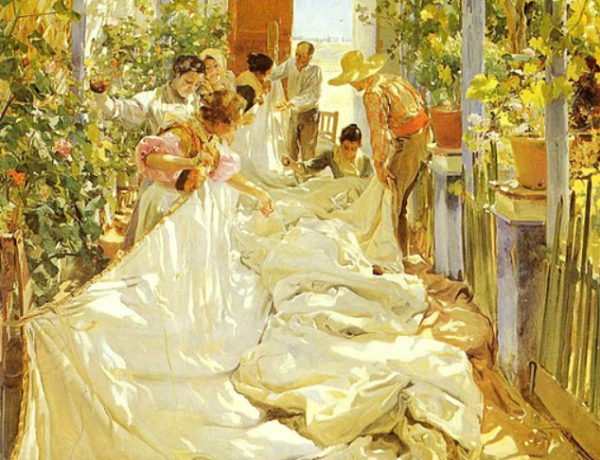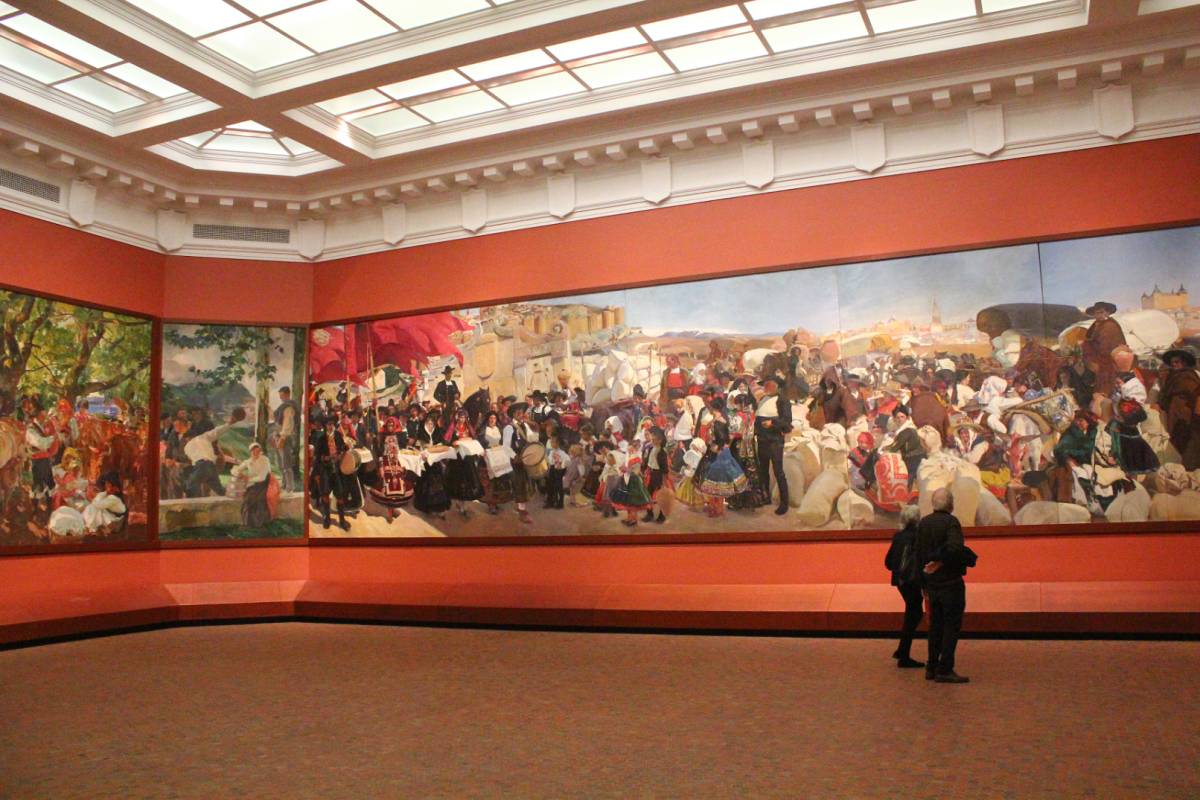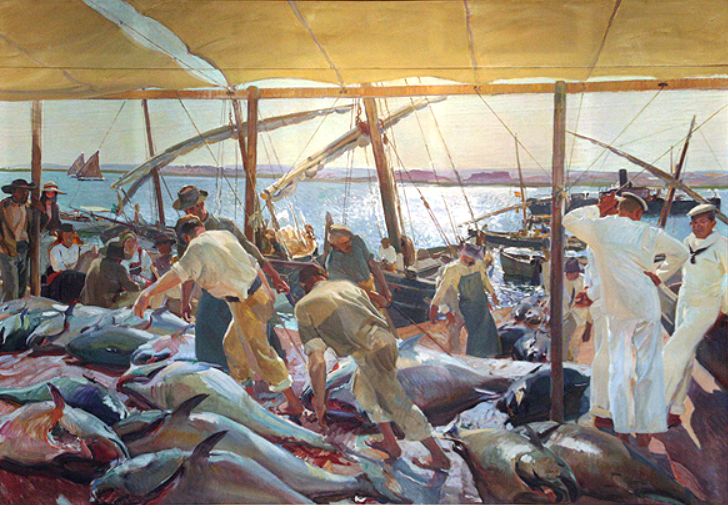Faced with the dimly lit entrance of the museum, I look left, right, up, and down as I make my way to the first room. To my left and right are closed off staircases that lead to the upper floor. The floors, I notice, are covered in hexagonal terracotta tiles. Occasionally, I find a few with designs inscribed into them; castles, trees, and flowers are among these ‘easter egg’ decorations. These same shapes trail my steps throughout my visit to the Hispanic Society.
The Hispanic Society
The ultimate goal of the Hispanic Society is to preserve, study, and appreciate art from predominantly Spanish and Portuguese-speaking countries. Its founder, Archer Milton Huntington (1870-1955), dedicated the majority of his life to making advancements in Hispanic studies and collecting art for a “Spanish Museum.” As Huntington was born from a wealthy family in New York City, he was given a private education that exposed him to the classical languages, history, literature, and, most importantly, travel.
Huntington’s early travels to foreign countries stimulated his passion for museums. He developed a love specifically for Spanish art and literature in his visit to Europe and eventually received an education in art history and the Spanish language. Huntington’s interest in Hispanic studies seeped into adulthood, and his accumulation of thousands of books overflowed as he traveled overseas. Over time, he had acquired various collections of artwork and the finest Spanish literature of the period. Huntington poured all of his time into the museum and, finally, founded The Hispanic Society of America in 1904.
Since its opening, the Hispanic Society has housed thousands of works including, most notably, works by Francisco Goya, El Greco, Diego Velázquez, Joaquín Sorolla, Pablo Picasso, and Luisa Roldán. The Hispanic Society’s main court currently resides in the Audubon Terrace in Upper Manhattan between 155th and 156th Street, alongside the museum’s East Building Gallery, Library Reading Room, and the Sorolla Room.
Visitors are first met with a large bronze statue of Spanish hero El Cid Campeador surrounded by four life-size bronze soldiers. Additional bronze sculptures of a stag and doe with fawn and two limestone lions at the stair entrance accompany El Cid in the terrace. Created by sculptor Anna Hyatt Huntington, Milton Huntington’s wife, the animals lie before the neoclassical-style building. The north side of the building facing the statues is decorated with columns, a decorated tympanum, and the text “The Hispanic Society of America” right below it. Its grandeur carries into the interior of the building but the monochromatic and Classical style is quickly abandoned.
Upon entering the building, the harshness of the museum’s limestone exterior quickly melts away into warmth of its interior: a floor of red-clay hexagonal tiles spreads across the majority of the main room, where the windowless walls, cloister-like appearance, and ornate terra-cotta colored arches frame the room and its paintings, making the space all the more intimate.
Contrary to what the exterior may suggest, the main court is small with little space to move freely. In both of my visits to the Hispanic Society, I did not encounter more than four groups of people but strangely could not get further than five feet from the next visitor.
The heavily decorated terracotta arches of the main court, meant to replicate a 16th century Spanish patio, cover even the corners of the room and act as windows into Spain that look out on the current exhibition in the gallery. Up until March of this year, the Hispanic Society will continue to present its A Collection Without Borders exhibition with Diego Velázquez’s Portrait of a Little Girl (ca. 1638-1644) at its forefront.
Picasso at the Hispanic Society
To the left of the main court was a nook filled with works from the temporary exhibition Picasso and The Spanish Classics. In the exhibition, Picasso employs the Spanish language and works by Spanish literary figures, Luis de Gongora y Argote and Miguel de Cervantes, to reconnect with his native Spain. The Hispanic Society’s Project Room displayed the exhibition until February 4th, 2024, along with a series of Picasso’s portraits and poems.
In response to Miguel De Cervantes’ ‘Don Quixot’’, at the very back of the room, Picasso drew more focus on the subjects, Don Quixote and his horse, than on the story itself. The story of Don Quixote tells of a man who journeys through a series of quests to become a knight; in the process he slowly submits to insanity. Picasso deviates the focus from the hero and an attack on the windmills in the background and instead emphasizes the juxtaposition between Don Quixote and everything else, including his squire Sancho and his horse, by experimenting with different mediums. The harsh and thin pen lines that make up his face contrast to the loose and thick aquatint, a printing technique that looks similar to watercolor, of the background and other figures. The sharp lines signal his mental decay and descent to madness as he removes himself from reality.
When I think about Picasso, I think of Cubism, modern art, color, and large, disproportionate shapes. Although the fundamental elements of his art style are still apparent, sharp lines and the black-and-white of each piece overcame any of my prior expectations. Similar examples of Picasso’s monochrome works, but in the Cubist style, were recently presented at the MET’s ‘Picasso: A Cubist Commission in Brooklyn’ exhibition.
Throughout the exhibition, visitors of the Hispanic Society were exposed to a unique perspective of Picasso’s thought process as he navigated through Spanish stories, sonnets, and poems.
Joaquín Sorolla y Bastida
Joaquín Sorolla y Bastida (1863-1923) was a Spanish artist who was dubbed “The Spanish Master of Light.” At a young age, he developed his love for art through drawing classes and his study of the traditional masters. Sorolla was particularly inspired by artists El Greco and Diego Velázquez. Heavily influenced by his later studies in Classical art and the raging new impressionist movement, it was as if he created a personal subsect of the two art movements.
The large brushstrokes of impressionism shine in his work. Despite this, in the paintings of Joaquín Sorolla y Bastida, the unnoticed is revealed.
The saturation of his surroundings is amplified and the small shifts in movement are noted with each decision. The subjects of his paintings are revitalized and captured within a single moment in time such that the viewer, even decades in the future, can look at them and witness that moment for themselves.

Picture an unstill body of water on a sunny day. There may be ripples of water from a water spider that just moved in a lake or heavy waves coming into the sandy shore at a beach. Imagine the sun reflecting onto the water. Imagine the shimmering waves and the occasional blinding shine as they move.
Sorolla especially focused on the Spanish sunlight and the water off the coast of Valencia. Overall, he aimed to capture daily Spanish life between the late 19th century and the early 20th century. At the time, many European artists, like Pablo Picasso, pursued the newly popularized movement known as Modernism. Although these artists created pieces that embodied Spain, very few could directly assert the Spanish identity in their art through a display of Spanish traditions, life, and environment. Sorolla represented both the struggles and the joys the people faced at the time. In his oil painting Sewing the Sail (1896), for example, Sorolla revealed the conditions women were forced to work in. The creases of the fabric sail and the congested, closed in setting build on the depiction of the realities of workers in Spain especially under the heat of the sun.
In ‘Joaquín Sorolla’s Vision of Spain Ninety Years On’, Felipe Garín and Facundo Tomás wrote, “We love this painter not because he represents us, but because…he gives us an identity which would not exist without him.”
From the clothing they wore to the chores they practiced within that period, Sorolla encapsulates a time that soon fled. In the early 20th century Spain was making its way to a culture shift and modernity. Through the Treaty of Paris (1898), Spain relinquished its remaining colonies to foreign powers and the once fierce nation grieved for an earlier time. Eventually, Spain resorted to urbanization and industrialization. Many left rural areas of Spain and turned to city life, which offered better pay and working conditions. Multiple aspects of Spanish culture were, for the most part, traded off for ‘popular culture’ as a result of the excitement for new entertainment. Football largely replaced the interest in bullfighting and cinema did so with light operas (zarzuelas).
As a result of his thorough presentations of Spanish life within the late 19th century and early 20th century period, Sorolla became a highly influential artist in Spain and was respected as one who had cemented the memory of a piece of the nation.
Sorolla’s Vision of Spain at the Hispanic Society was created with this continued objective. By 1911, Sorolla had already been featured in two of the museum’s traveling exhibitions and had become close with the founder of the Hispanic Society, Archer Milton Huntington. That same year, Huntington commissioned a piece that encapsulated Spain into a gallery. Both Sorolla and Huntington observed the fleeting part of Spain featured in the painting. Things were changing and Sorolla was able to catch up in time to record it.
Vision of Spain
From one end of the room (Tuna Catch at Ayamonte) to the other (The Fish Market at Catalonia) was approximately 54.5 of my own feet. As this is not the most precise form of measurement, I definitely recommend observing the grandness of the room for yourself!
The space is crucial to how Sorolla’s Vision of Spain is displayed since the walls of the room make up the shape of an irregular polygon to ensure that all 14 canvases fit; one to two pieces take up each wall. The Vision of Spain tells a continuous story of daily Spanish life between 1912 and 1919, the closing years of this period in Spain. It is important to recognize that the pieces within Vision of Spain, though one painting in total, must be recognized and analyzed individually.
Ayamonte
The fourteen canvases make up a piece 200 feet long and 12 feet high that highlight nine regions in early 20th century Spain. With such a large scale, there is less demand for thin, fine brushstrokes and more for the larger image.
In Tuna Catch at Ayamonte, the first piece I was drawn to, the canvas is overtaken by strokes of watered down paint and, contrarily, thick clumps of paint plastered onto the surface. From up close, we can understand the simplicity of each broad stroke. From afar, we can edit our perspectives and recognize that every decision and juxtaposition that Sorolla made ties into the painting’s overall complexity.
Here, the thick paint in various shades of white shine heavy sunlight onto the fish, the water, and the centermost worker. The watered-down paint makes Sorolla’s quick but careful strokes all the more visible. The yellow light through the tarp is casted onto the backs of the two main workers. The light on the tuna, the blue light from the sea, and the softer light through the tarp work hand-in-hand to emphasize the heat of Ayamonte, Spain.
Ayamonte is a town in the west coast of Andalusia, the southernmost region of Spain, where fishing was, and still is, especially prevalent and important. Large tuna populate the region and fishermen trade with Portuguese sailors. Sorolla acknowledged the position fishing had on the growth of Spanish industry, the import and export of goods, and how it set the scene for many years of the continued practice to come.
In another portion of the Vision of Spain piece, The Fish at Catalonia, Sorolla also chose to feature fish but focused more on the transport and the identity of Catalonia with its fish markets, trade, and hats called barretinas, which were worn during a period of rebellion. Fun fact(s): purple barretines were typically worn by sailors, while red barretines were for the other men and youth of the town. Although they are not commonly in use today, they are still used in traditional dances around that region.
Castile
The idea of Vision of Spain is to capture Spain into a painting. But rarely is a nation made up of a singular, uniform culture, and 1920s Spain was no exception. So, Sorolla divided Spain into sections. No, he did not capture every single culture or subculture within a region, but he managed to display the ‘feeling’ of Spain. Across the canvases, he goes from Seville to Valencia to Andalusia, from Catalonia to Ayamonte to Navarre. However, in his painting for Castile, The Bread Festival, he picks at distinct and separate identities within the Old and New Castile. The Old Castile, the Northern region of Castile, was originally named “[The kingdom of] Castile” until the New Castile, the Southern region, was annexed.
The Bread Festival takes up an entire wall in the room and is the first thing you see as you enter. I observed the painting from left to right. The first thing I noticed was the amount of people in the painting. All the way to the left of the painting is a crowd of people with flags, drums, and bread. With the enormity of the canvases, the majority of the faces on the left side are blurred and occasionally indistinguishable from one another.
In the Vision of Spain, the context of its size makes all the difference. If we were to focus only on the left side of the Bread Festival wall, we could notice the blur and the lack of detail in each face. Take a step back, and all of a sudden it all comes together. The shadows and the light on each individual are enough for the viewer to imagine the rest as if they were in the Old Castile themselves.
The left side of the canvas features the Old Castile, made up of Astorga, Alberca, Salamanca, León, and Zamora. The woman closest to the left wears an abundance of jewelry, a decorated skirt, and a mantle over her head, characteristic of the costuming in Segovia, at the center of the Old Castile. The other women carrying the bread wear traditional dresses from the Maragateria region, in the southwest of León, which had developed as a result of Muslim influence in the region prior to the 1920s.
It is important to recognize that Sorolla did not paint to depict a specific festival that took place in Spain but to provide a unity between the Old and the New Castile by means of the festival. The people across the wall were picked from different regions, different times, and had been preserved in different ways. To best fit an entire section of Spain into a singular composition, Sorolla borrowed from his various sketches and models throughout his travels, including those painted from life, or en plein air.
At the center of the piece, between the Old and the New Castile, are children dressed in folk wear lying below the mountain range separating the two regions. To the right, people from Toledo, Talavera de la Reina, Lagatera, and Ávila make up the New Castile. Sacks of flour stretch across the foreground and pile in the background inside carriages pulled along by horsemen. The New Castile region produced a lot of wheat and olives at the time. Consequently, Sorolla painted characters along the remainder of the piece carrying and transporting sacks of flour and large ceramics filled with wine, depicting the agricultural identity of the New Castile.
As you walk from one end of the painting to the other, you may notice the singular figure that looks forward. At the very center of the piece’s second half, despite any noise of the bustling atmosphere, is a nursing mother who directly faces the viewer. Knowing that Sorolla broke up scenes from a variety of settings, it’s very likely that he painted or sketched her individually before, making her stand out and seem out of place among the other people that are absorbed in what they are doing. It is possible that she is not looking in our direction at all, though the blur between the shadows in her face and her eyes makes it appear as if she is staring at the viewer.
Sorolla managed to capture these small details with large brush strokes because of the large scale of the paintings in Vision of Spain. The series of paintings he curated embody the cultures of Spain. The Vision of Spain highlights the diversity of Spain and the culture that fled soon after the painting’s creation. In a time of abstract art movements and representational modern art, Huntington commissioned Sorolla, an Impressionist painter, to capture the Spain of the period. He hoped to give some permanence to the fleeting cultures of Spain as the nation made its way to urbanization and drew itself to modern, popular culture.
As of January 26, 2024 five new Sorolla paintings have made their way into the Hispanic Society and can be viewed in the main court. The Hispanic Society Main Gallery is open from 12 P.M. to 5 P.M. from Thursday to Sunday every week with the exception of holidays. For more on visiting hours: https://hispanicsociety.org/visit/visitor-information/.
The ultimate goal of the Hispanic Society is to preserve, study, and appreciate art from predominantly Spanish and Portuguese-speaking countries.



